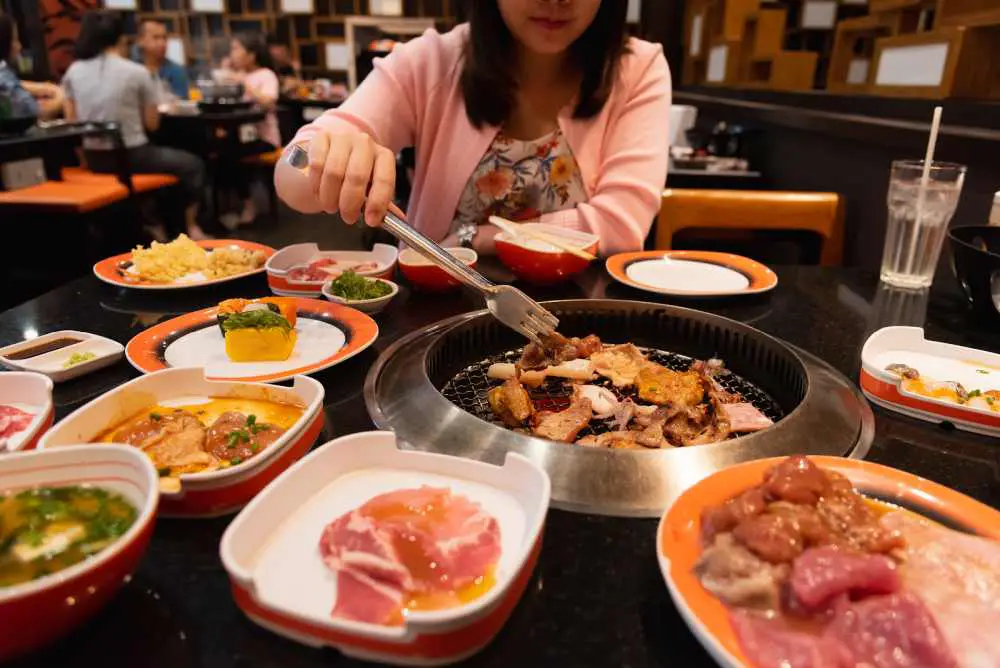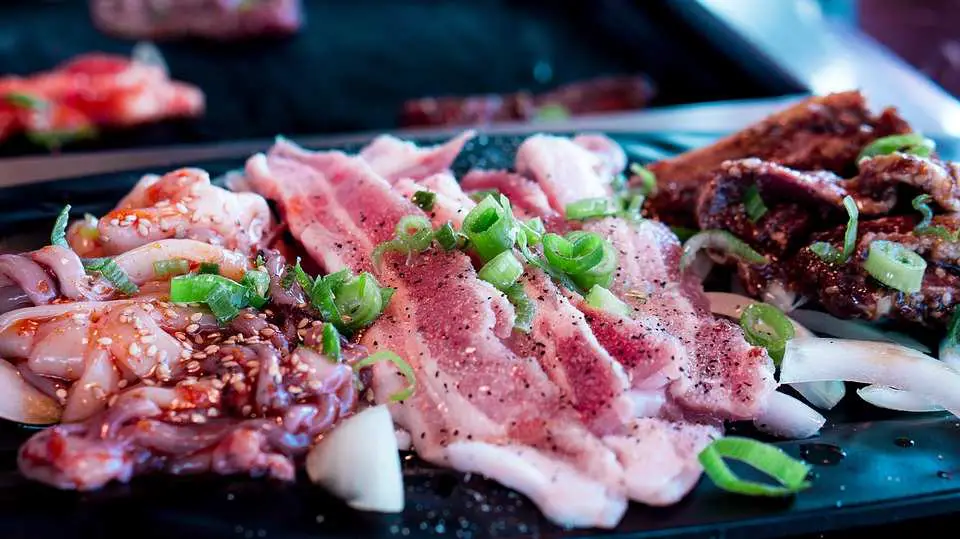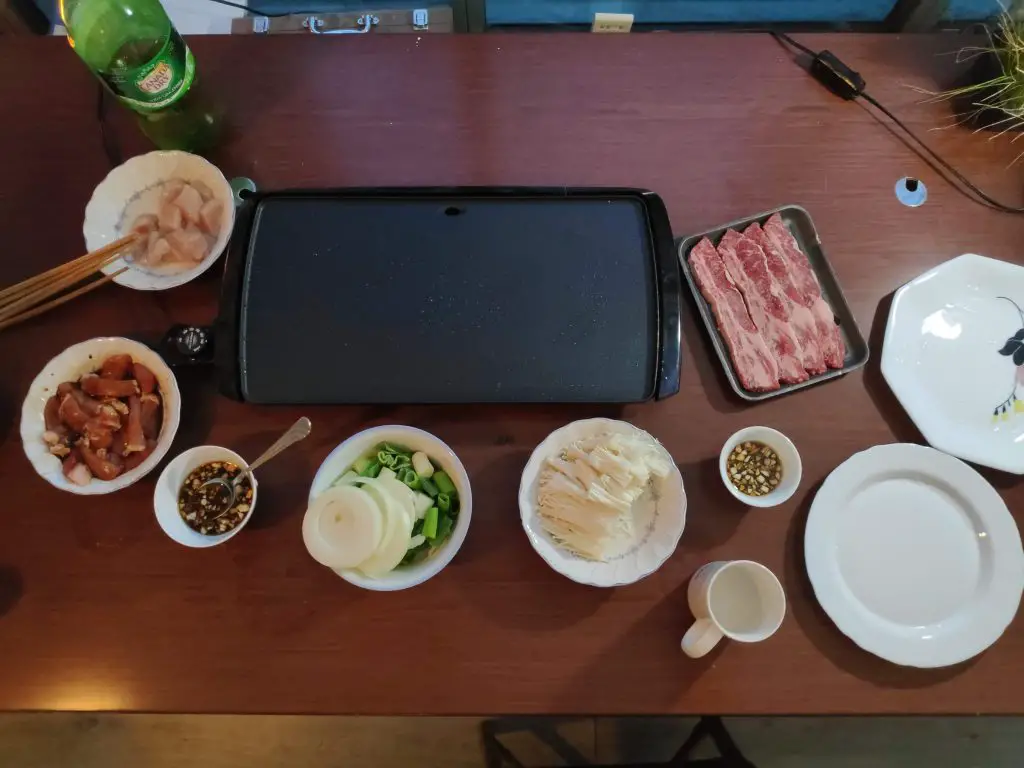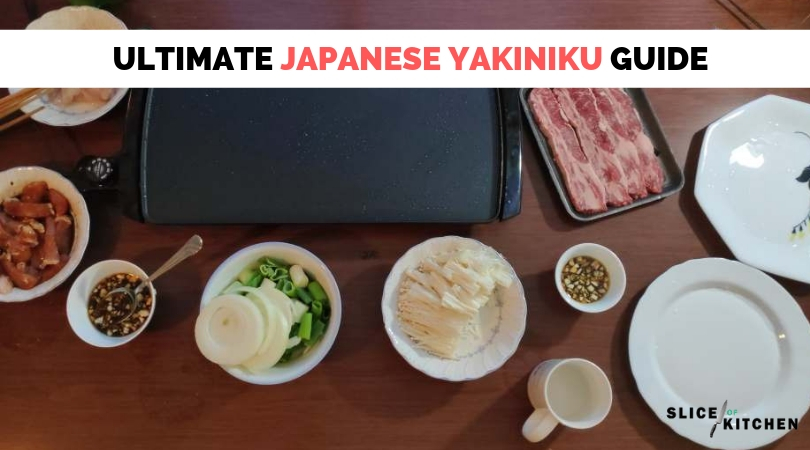I think I can safely say everyone loves a good BBQ.
Instead of always doing the same old thing, why not surprise your friends with something different- a Japanese BBQ party instead! I’ve been hosting a few yakiniku (Japanese BBQ) parties lately, and all my friends absolutely love it!
Table of Contents
What Is Yakiniku?

Yakiniku is a Japanese term that refers to grilled meat cuisine. It’s called ami-yaki if grilled on a net and teppanyaki if on an iron plate. Aside from meat, Japanese barbecue is served with vegetables and different types of dips. The bite-sized meat and vegetables are grilled over charcoal or either an electric or gas grill.
Restaurants that serve yakiniku often give their customers covers for their clothes. The interior also often has excellent ventilation for smoke-free dining.
Quick History
The history of yakiniku can be traced back to the Showa period when Korean foods such as bulgogi and galbi influenced Japanese cuisine. Korean immigrants opened grilling shops and used parts of the meat which the Japanese used to discard such as tripe and large intestine. It was a hit since the locals loved it for its smoky flavor. Later on, more meat cuts would be used, and yakiniku would be known as one of the specialties of Japanese cuisine.
What Kinds of Meat Are Best for Yakiniku?

One of the things you’ll notice about yakiniku meat is that they often don’t come pre-seasoned or marinated. This is because it focuses on the natural flavor of the meat. In fact, some people prefer to just add a bit of salt and a squeeze of lemon to highlight the meaty taste instead of using the tare or dipping sauce. Another reason is that marinated meat burns faster.
The best kind of meat for yakiniku is, of course, wagyu. It’s rated class A to C depending on the portion of meat while the marbling grade ranges from 1 to 5. The highest class of Japanese beef that you can get is A5, which stands out for its superior marbling, tenderness, and umami. It is, however, very hard to get authentic wagyu outside of Japan.
There are also a lot of beef cuts that are popular with yakiniku. They are:
Zabuton (Chuck Flap)
A rare cut of beef that has even marbling, it is taken from the ribcage area. This flavorful beef cut melts in your mouth especially when cooked rare.
Misuji (Top Blade)
Taken from a small area under the cow’s shoulder blade, the rich umami flavor of the misuji shines in a yakiniku. It’s a rare cut, but it’s a must-try if you can get your hands on some especially if you love lean meat. Lightly brown the surface and cook it rare.
Kurimi (Chuck Eye)
If you prefer lean meat and a strong umami taste, then give the kurimi a try. It is tougher compared to fatty cuts, so you have to be careful not to overcook it. As such, I recommend eating this rare. If you slice it thin, just sear it, and you’re good to go.
Togarashi (Chuck Tender)
Just like the misuji, the togarashi is located near the shoulder blades and has a low yield per cow. Juicy and flavorful, it is recommended to be grilled until rare doneness.
Sankaku Bara (Chuck Short Rib)
Named after its triangular shape, the sankaku bara can be found in the area near the first and sixth ribs. It has a good ratio of fat and lean meat. Cook it until medium rare, and you’ll be able to enjoy the sweetness and juiciness of the fat as well as the umami of the lean meat at the same time.
Koune (Brisket)
Found just under the sankaku bara, this is a tough but intensely flavored cut of meat. Good restaurants serve this without the fat. Cook it longer if you didn’t remove the fat. But, if you did, medium-rare doneness is recommended using low heat.
Rib Cap
Found behind the rib, the rib cap is a finely marbled meat cut that is bursting with sweet fat and umami. If sliced thinly, cook it over high heat until the fat has melted. If you sliced thickly, grill it until its heated through.
Ribeye
A premium cut of meat that some consider to be the best, the ribeye is taken from the center of the ribs. Aside from being extremely tender, it has a good ratio of fat and lean meat. I recommend slicing this thinly so that you can lightly sear it and eat it rare.
Tomo Bara (Short Plate)
A standard offering for yakiniku restaurants, the tomo bara can be found in the ribs’ ventral section. This cut of meat is flavorful and slightly sweet. Cook it into medium doneness until the fat has caramelized.
Sasabara (Flank)
The sasabara is taken from the upper area of the hind leg joints. Tender and packed with umami, this cut stands out for its mellow flavor. Browned over high heat, medium rare is the way to go.
Hireshita (Sirloin)
Taken from the back of the cow, sirloin is fatty and tender. It is one of the most popular and most expensive cuts of beef. Depending on the quality, you can cook sirloin rare with the surface seared to trap the juices.
Hire (Tenderloin)
The hire is lean and tender with a hint of sweetness and a strong savory flavor. Serve this in thick slices and cook slowly over low heat until rare.
Chateubriand
If you feel like splurging, get some of the chateubriand which is an extremely tender and slightly sweet cut of meat. Grill the thick slices over low heat until rare, and the surface is browned..
Rump
The rump is a good choice if you like your meat beefy, tender, and finely textured. It’s good in both thick and thin cuts and when grilled until rare.
Habaki (Heel)
If you prefer a strong beefy taste over rich fat, the habaki is an excellent pick. Just make sure not to overcook or it might get tough.
Shintama (Knuckle)
Even with the tendons, the shintama is surprisingly tender. It is a low-fat cut of meat that has a mild flavor. Sear the surface to seal in the juice and grill until rare.
What Other Ingredients are Popular with Yakiniku?

Aside from beef and offal, there are many other ingredients that you can add to your yakiniku.
- Pork – Fatty cuts of pork like the belly, neck, and cheeks work great for yakiniku. Slice them thin and grill until crispy.
- Chicken – Chicken breast is a good option if you’re trying to watch your weight.
- Seafood – Fresh seafood is a great way to level up your yakiniku. Shellfishes, squids, and prawns are some of the most popular choices.
- Vegetables – Almost all types of vegetables are compatible with Japanese barbecue. Bell pepper, corn, carrots, mushrooms, onions, eggplant, bean sprout, garlic, potatoes, zucchini, and kabocha squash are excellent picks. You can also get some cabbage or lettuce leaves to make wraps. Pickled or fermented vegetables like kimchi are a must for me.
- Carbs – Pair your yakiniku with some steamed rice and noodles for a balanced meal.
Yakiniku Recipe
Yakiniku is one of those things where just about anything goes. Pick your favorite ingredients above and prepare them according to the instructions below. When it comes to vegetables, I often pick the ones that are in season since they are cheaper and tastier.
Before I continue, check out this video of my last yakiniku party with my Japanese housemates:
Preparation
- Chill your meat for a couple of hours and cut into 3 to 5 mm thick slices.
- Marinate offals such as the heart in some sesame oil and minced garlic. This helps in removing the “organy” taste.
- Create an authentic yakiniku sauce to dip your meats in, or pour over the meats as you grill. Either way, they will taste absolutely amazing.
Yakiniku Dipping Sauce Recipe
- 3 parts soy sauce
- 1 part mirin (Japanese cooking wine)
- 1 part cooking sake
- 1 part sugar
- 1/2 part ground garlic
- 1/3 part ground ginger
- 1/3 part sesame oil
- Pinch of salt
Simply mix all the ingredients above together to create the yakiniku sauce. Check out my video below for more details:
Preparing the Vegetables
Slice the vegetables into strips. You can cover items like mushrooms in tin foil to steam instead of grill them.
Directions
There really is no fixed way when it comes to yakiniku. Like I’ve said, anything goes and having fun with your family and friends is more important. Still, here are some things you need to keep in mind.
- Preheat your grill for a couple of minutes.
- Place your meat and grill them until they reach your preferred doneness. You can also follow my recommendations above when it comes to the doneness per type of meat cut.
- Thin, fatty slices of meat often only need 3 to 5 seconds of grilling while thick, lean slices may require up to 2 minutes of cooking.
- Remember not to overcrowd your grill so that the temperature doesn’t go down.
- To prevent cross-contamination, use different tongs for your raw meat, vegetables, and cooked meat and vegetables.
- Root crops like potatoes and carrots go first because they take longer to cook.
- Be careful not to add too many fatty pieces on your grill at a time since it might go up in flames. In case it happens, stay calm and remove the food from the fire. You can also use ice cubes to put out the fire.
- Finally, dip your grilled food into your yakiniku sauce and enjoy!
Horumon- A walk on the wild side for the more adventurous
To really experience all that Japanese Yakiniku has to offer, I highly recommend opening your mind and trying some, well, let’s just say,
Horumon, which literally means “discarded items”, is where the yakiniku craze started. It mostly refers to beef offal, but pork stomach and uterus are also included.
Gyutan (Tongue)
Considered to be a delicacy for its scarcity, the tongue is juicy and tender. Served in thin slices, it is grilled on one side while the other is left rare.
Hatsu (Heart)
Though full of muscle tissue, hatsu is tender and has just the right amount of fattiness and aroma. It’s best eaten rare with only one crispy grilled side. But, you can cook it up to medium-rare.
Mino (Tripe)
The thickest out of all the stomachs of the cow, the tripe requires proper cleaning to get rid of the remnants of the cow’s food. But, if properly cleaned, even those who aren’t familiar with offal will be able to eat it. Grill tripe until browned, and enjoy its chewy texture and slightly sweet taste.
Reba (Liver)
The liver is one of my favorite things to grill, but I’ve found that this is an acquired taste. Light and tender, the fresher the liver you grill, the better it tastes. It tastes sweet and savory especially if cooked until medium-rare.
Marucho (Small Intestine)
Aside from being popular for its sweet and rich flavor, women like eating it for its collagen content. Turn it inside out, and cut into bite-sized slices prior to serving. Slowly cook over low heat until medium.
Tips on Slicing Meats Thinly for Yakiniku
Once you’ve chosen the meat that you like, here are some tips that you can use to slice your own meat thinly for yakiniku.
- The one thing you need to remember when slicing meat thinly is to place it in a freezer bag and chill it in the freezer for 1 to 2 hours first. This makes the meat firm enough for your knife to go through smoothly.
- Use a very sharp knife to slice your chilled meat in a gentle sawing motion. A Japanese kitchen knife like the sujihiki would work great for this purpose.
- To ensure that the meat will become tender once grilled, make sure to slice against the grain of the beef.
Here’s a quick video combining our first three tips:
- Unlike sukiyaki meat which is typically 1.5 to 3 mm in thickness, yakiniku meat are sliced into 3 to 5-mm thickness.
- If you prefer having uniform meat thickness, an electric meat slicer can quickly get the job done for you. It’s also a great choice if you need to slice big batches of meat. Just make sure to check out these safety tips first.
And there you have it! All the information you need to host the perfect yakiniku party at home!

